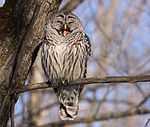Yawn
| Yawn | |
|---|---|
 Joseph Ducreux pandiculating; self-portrait ca. 1783 | |
| Organisms | Vertebrates |
| Biological system | Nervous system |
| Health | Unaffected or Beneficial |
| Action | Involuntary |
| Stimuli |
Fatigue Boredom Stress Others yawning |
| Method | Complete extension of jaw, inhalation, eyes close, stretching of the eardrums, exhalation |
| Duration | 6 seconds |
A yawn is a reflex of simultaneous inhalation of air and stretching of the eardrums, followed by exhalation of breath. Pandiculation is the act of yawning and stretching simultaneously.[3]
Yawning in adults occurs most often immediately before and after sleep, during tedious activities and as a result of its contagiousness,[1] and is commonly associated with tiredness, stress, overwork, lack of stimulation and boredom, though studies show it may be linked to the cooling of the brain.[4] In humans, yawning is often triggered by others yawning (e.g., seeing a person yawning, talking to someone on the phone who is yawning) and is a typical example of positive feedback.[5] This "infectious" yawning has also been observed in chimpanzees, dogs, and can occur across species.[6][7] Approximately 20 physiological reasons for yawning have been proposed by scholars, but there is little agreement about its main functions.[1]
Etymology
Yawn comes from Old English 'Ginian' and 'Gionian' meaning to "Open the mouth wide, gape," which in turn comes from the Proto-Germanic base gin-.
Proposed causes

There are a number of theories that attempt to explain why animals and people yawn.[8][9] It is likely that there are a number of triggers for the behavior. However, there are a few theories that attempt to explain the primary evolutionary reason for the yawn. None of them has been empirically substantiated.
One study states that yawning occurs when one's blood contains increased amounts of carbon dioxide and therefore becomes in need of the influx of oxygen (or expulsion of carbon dioxide) that a yawn can provide.[8][10] Yawning may in fact reduce oxygen intake compared to normal respiration.[11] But giving people additional oxygen didn't decrease yawning, and decreasing the amount of carbon dioxide in a subject's environment also didn't prevent yawning.[12]
Another speculated reason for yawning is the desire to stretch one's muscles.[13] The tongue and throat are some of the most used muscles in the body, used for speech, breathing and swallowing. The need to stretch these muscles and refresh them arises just like in other muscles of the body, to ensure that they do not cramp.[citation needed] Yawns are often accompanied by the urge to stretch. Still another proposal points out that animals subject to predation or other dangers must be ready to physically exert themselves at any given moment. At least one study suggests that yawning, especially psychological "contagious" yawning, may have developed as a way of keeping a group of animals alert.[14] If an animal is drowsy or bored, it may not be as alert as it should be to spring into action. Therefore, the "contagious" yawn could be an instinctual reaction to a signal from one member of the group reminding the others to stay alert.
Nervousness has also been suggested as a possible reason. Nervousness often indicates the perception of an impending need for action. Anecdotal evidence suggests that yawning helps increase the state of alertness of a person. Paratroopers have been noted to yawn in the moments before they exit the aircraft.[15]

Another notion states that yawning is the body's way of controlling brain temperature.[16][17] In 2007, researchers including a professor of psychology from the University of Albany proposed that yawning may be a means to keep the brain cool. Mammalian brains operate best within a narrow temperature range. In two experiments, they demonstrated that both subjects with cold packs attached to their foreheads and subjects asked to breathe strictly nasally exhibited reduced contagious yawning when watching videos of people yawning.[16][18] A similar recent hypothesis is that yawning is used for regulation of body temperature. Similarly, a study by Jared Guttmann and Celena Dopart at Worcester Polytechnic Institute found that when a subject wearing earplugs yawned, a breeze is heard caused by the flux of the air moving between the subject's ear and the environment.[19] Researchers Guttmann and Dopart determined that a yawn causes one of three possible situations to occur: the brain cools down due to an influx or outflux of oxygen, the pressure in the brain is reduced by an outflux of oxygen, or the pressure of the brain is increased by an influx of air caused by increased cranial space.
Another hypothesis is that yawns are caused by the same chemicals (neurotransmitters) in the brain that affect emotions, mood, appetite, and other phenomena. These chemicals include serotonin, dopamine, glutamic acid, and nitric oxide. As more (or less) of these compounds are activated in the brain, the frequency of yawning increases. Conversely, a greater presence in the brain of opioid neurotransmitters such as endorphins reduces the frequency of yawning. Individuals in opioid withdrawal exhibit a greatly increased frequency of yawning. Patients taking the selective serotonin reuptake inhibitors Paxil (paroxetine HCl) or Celexa (citalopram) have been observed yawning more often.[citation needed] Excessive yawning is more common during the first three months of taking the SSRIs. Anecdotal reports by users of psilocybin mushrooms often describe a marked stimulation of yawning while intoxicated, often associated with excess lacrimation (eyes producing tears) and nasal mucosal stimulation, especially while "peaking" (undergoing the most intense portion of the psilocybin experience). While opioids have been demonstrated to reduce this yawning and lacrimation provoked by psilocybin,[citation needed] it is not clear that the same pathways that induce yawning as a symptom of opioid abstinence in habituated users are the mode of action in yawning in mushroom users. While even opioid-dependent users of psilocybin on stable opioid therapy often report yawning and excess lacrimation while undergoing this entheogenic mushroom experience, there are no reports on mushrooms in the literature regarding habituated users experiencing other typical opioid withdrawal symptoms such as cramping, physical pain, anxiety, gooseflesh, etc.
Recent research carried out by Garrett Norris, a lecturer in psychology at the University of Leeds, involving monitoring the behavior of students kept waiting in a reception area indicates a connection (supported by neuro-imaging research) between empathic ability and yawning. "We believe that contagious yawning indicates empathy. It indicates an appreciation of other peoples' behavioral and physiological state." says Norris.[20]
Yawning behavior may be altered as a result of medical issues such as diabetes,[21] stroke,[22] or adrenal conditions.[23]
To look at the issue in terms of a possible evolutionary advantage, yawning might be a herd instinct.[24] For example, theories suggest that the yawn serves to synchronize mood in gregarious animals, similar to the howling of the wolf pack. It signals tiredness to other members of the group in order to synchronize sleeping patterns and periods.

The yawn reflex has long been observed to be contagious. In 1508, Erasmus wrote, "One man's yawning makes another yawn.,"[25] and the French proverbialized the idea to "Un bon bâilleur en fait bâiller sept." ("One good gaper makes seven others gape").[26] Often, if one person yawns, this may cause another person to "empathetically" yawn.[11] Observing another person's yawning face (especially his/her eyes), even reading, or thinking about yawning, or looking at a yawning picture can cause a person to yawn.[11][27][28] The proximate cause for contagious yawning may lie with mirror neurons in the frontal cortex of certain vertebrates, which, upon being exposed to a stimulus from conspecific (same species) and occasionally interspecific organisms, activates the same regions in the brain.[29] Mirror neurons have been proposed as a driving force for imitation which lies at the root of much human learning such as language acquisition. Yawning may be an offshoot of the same imitative impulse.
A 2007 study found that young children with autism spectrum disorders do not increase their yawning frequency after seeing videos of other people yawning, in contrast to typically developing children. In fact, the autistic children actually yawned less during the videos of yawning than during the control videos. This supports the claim that contagious yawning is related to empathic capacity.[30]
The relationship between yawn contagion and empathy is strongly supported by a 2011 behavioral study, conducted by Ivan Norscia and Elisabetta Palagi (University of Pisa, Italy). The study revealed that — among other variables such as nationality, gender, and sensory modality — only social bonding predicted the occurrence, frequency, and latency of yawn contagion.[31] As with other measures of empathy, the rate of contagion was found to be greatest in response to kin, then friends, then acquaintances, and lastly strangers.[31] Related individuals (r≥0.25) showed the greatest contagion, in terms of both occurrence of yawning and frequency of yawns.[31] Strangers and acquaintances showed a longer delay in the yawn response (latency) compared to friends and kin.[31] Hence, yawn contagion appears to be primarily driven by the emotional closeness between individuals.[31]
Yawning has been observed among various primates. In these cases the yawn is a threat gesture, a way of maintaining order in the primates' social structure. Specific studies were conducted on chimpanzees[32] and stumptail macaques.[33] A group of these animals was shown a video of other conspecifics yawning; both species yawned as well. This helps to partly confirm a yawn's "contagiousness".
The Discovery Channel's show Mythbusters also tested this concept. In their small-scale, informal study they concluded that yawning is contagious.[34]
Gordon Gallup, who hypothesizes that yawning may be a means of keeping the brain cool, also hypothesizes that "contagious" yawning may be a survival instinct inherited from our evolutionary past. "During human evolutionary history, when we were subject to predation and attacks by other groups, if everybody yawns in response to seeing someone yawn the whole group becomes much more vigilant and much better at being able to detect danger."[18]
A study by the University of London has suggested that the "contagiousness" of yawns by a human will pass to dogs. The study observed that 21 of 29 dogs yawned when a stranger yawned in front of them, but did not yawn when the stranger only opened his mouth.[6] A recent study from Lund University showed that dogs, like humans,[35] develop a susceptibility to contagious yawning gradually, and that while dogs above seven months 'catch' yawns from humans, younger dogs are immune to contagion.[36] The study also indicated that nearly half of the dogs responded to the human's yawn by becoming relaxed and sleepy, suggesting that the dogs copied not just the yawn, but also the physical state that yawns typically reflect.
Excessive yawning in multiple sclerosis and brain stem ischaemic stroke may link these different disorders because of common neurological pathways and hormone levels.[37] In particular, higher levels of the stress hormone, cortisol,[38] which is important in the hypothalamus-pituitary-adrenal (HPA) axis,[39] have been found in the saliva of human subjects following yawning.[37] This provides support for the Thompson Cortisol Hypothesis[37] which proposes elevations of cortisol during yawning episodes. Electromyographical data from yawning human subjects at Bournemouth University, UK, supports this hypothesis[37] and is the first capture of the yawn by physiological measurement, with representation as a “yawning envelope” signified by the electrical waveform.
A hypothesis which can be drawn from the accumulation of these numerous tests, of course, is that yawning is an operation with manifold functions, and that it is not a singular process. In this view, many variables decide when an individual's body yawns, but it is performed whenever the body needs the benefits of yawning.
Animal yawning
In animals, yawning can serve as a warning signal. For example, Charles Darwin, in his book The Expression of the Emotions in Man and Animals, mentioned that baboons yawn to threaten their enemies, possibly by displaying large canine teeth.[40] Similarly, Siamese fighting fish yawn only when they see a conspecific (same species) or their own mirror-image, and their yawn often accompanies aggressive attack.[41] Guinea pigs also yawn in a display of dominance or anger, displaying their impressive incisor teeth. This is often accompanied by teeth chattering, purring and scent marking. Adelie Penguins employ yawning as part of their courtship ritual. Penguin couples face off and the males engage in what is described as an "ecstatic display," opening their beaks and pointing their faces skyward. This trait has also been seen among Emperor Penguins. Researchers have been attempting to discover why these two different species share this trait, despite not sharing a habitat. Snakes yawn, both to realign their jaws after a meal and for respiratory reasons, as their trachea can be seen to expand when they do this. Dogs often yawn after seeing people yawn[6] and when they feel uncertain.[42] Fish can also yawn, and they increase this behavior due to lack of oxygen or excessive heat.[43]
- Animals yawning
-

Yawning dog
-
Yawning domestic cat
-

Yawning tiger
-

Yawning jaguar
-

Male lion yawning
-

Yawning macaque
-

Yawning pony
-

Barred Owl yawning
-
.jpg)
Yawning Crabeater seal (Lobodon carcinophaga)
Culture

Some cultures lend yawning spiritual significance. An open mouth has been associated with letting good immaterial things (such as the soul) escape or letting bad ones (evil spirits) enter, and yawning may have been thought to increase these risks.[44] Covering the mouth when yawning may have been a way to prevent such transmission.[44] Exorcists believe that yawning can indicate that a demon or possessive spirit is leaving its human host during the course of an exorcism.[45] Superstitions regarding the act of yawning may have arisen from concerns over public health. Polydore Vergil (c. 1470–1555), in his De Rerum Inventoribus, writes that it was customary to make the Sign of the Cross over one's mouth, since "alike deadly plague was sometime in yawning, wherefore men used to fence themselves with the sign of the cross...which custom we retain at this day."[46]
Yawning is often perceived as implying boredom, and yawning conspicuously in another's presence has historically been a faux pas. In 1663 Francis Hawkins advised, "In yawning howl not, and thou shouldst abstain as much as thou can to yawn, especially when thou speakest".[47] George Washington said, "If You Cough, Sneeze, Sigh, or Yawn, do it not Loud but Privately; and Speak not in your Yawning, but put Your handkerchief or Hand before your face and turn aside."[48] These customary beliefs persist in the modern age. One of Mason Cooley's aphorisms is "A yawn is more disconcerting than a contradiction." A loud yawn may even lead to penalties for contempt of court.[49]
References
- ↑ 1.0 1.1 1.2 Anderson, James R.; Meno, Pauline (2003). "Psychological Influences on Yawning in Children". Current psychology letters 2 (11).
- ↑ "Study on fetal yawning". Plosone.org. doi:10.1371/journal.pone.0050569?imageURI=info:doi/10.1371/journal.pone.0050569.g001 (inactive 2014-02-04).
- ↑ MedOnline.net, "pandiculate"
- ↑ Popular Mechanics, January 2012 edition
- ↑ Camazine, Deneubourg, Franks, Sneyd, Theraulaz, Bonabeau, Self-Organization in Biological Systems, Princeton University Press, 2003. ISBN 0-691-11624-5, ISBN 0-691-01211-3 (pbk.) p. 18.
- ↑ 6.0 6.1 6.2 Shepherd, Alex J.; Senju, Atsushi; Joly-Mascheroni, Ramiro M. (2008). "Dogs catch human yawns". Biology Letters 4 (5): 446–8. doi:10.1098/rsbl.2008.0333. PMC 2610100. PMID 18682357. Lay summary – BBC News (August 5, 2008).
- ↑ Madsen, Elanie E.; Persson, Tomas; Sayehli, Susan; Lenninger, Sara; Sonesson, Göran (2013). "Chimpanzees Show a Developmental Increase in Susceptibility to Contagious Yawning: A Test of the Effect of Ontogeny and Emotional Closeness on Yawn Contagion". PLoS One 8 (10): e76266. doi:10.1371/journal.pone.0076266. PMID 24146848. Lay summary – LA Times (October 16, 2013).
- ↑ 8.0 8.1 "Little mystery: Why do we yawn?". MSNBC Interactive. 2013. Archived from the original on 16 September 2013. Retrieved 16 September 2013.
- ↑ Chudler, Eric H (July 31, 2007). "Yawning...and Why Yawns are Contagious". University of Washington. Archived from the original on January 12, 2006. Retrieved 2009-10-03.
- ↑ Thinkquest.org, Brain: Organ of the Mind"
- ↑ 11.0 11.1 11.2 Provine, Robert; Tate, BC; Geldmacher, LL (2005). "Yawning". American Scientist 93 (6): 382–93. doi:10.1511/2005.6.532. PMID 3120687.
- ↑ "Yawning.. and why yawning is contagious". University of Washington. 31 July 2007. Retrieved 2012-11-16.
- ↑ Thinkquest.org, – "Brain: Organ of the Mind"
- ↑ "UAlbany News Release - What's in a Yawn ask UAlbany Researchers". University of Albany. 29 June 2007. Retrieved 7 December 2013.
- ↑ Hooper, Rowan (2 July 2007). "Yawning may boost brain's alertness". New Scientist. Retrieved 2009-09-01.
- ↑ 16.0 16.1 Gallup, Andrew C.; Gallup (2007). "Yawning as a brain cooling mechanism: Nasal breathing and forehead cooling diminish the incidence of contagious yawning". Evolutionary Psychology 5 (1): 92–101. Lay summary – Science Daily (June 21, 2007).
- ↑ "Discovery News". Retrieved 2008-12-15.
- ↑ 18.0 18.1 Gordon G. Gallup (2007). Good Morning America – The Science of Yawning (July 30, 2007) (TV-Series). USA: ABC.
- ↑ http://www.enn.com/health/article/43278/print
- ↑ Seward, Liz (2007-09-10). "Sign of empathy". BBC News. Retrieved 2013-07-20.
- ↑ Zheng, Hong; Bidasee, Keshore R.; Mayhan, William G.; Patel, Kaushik P. (2006). "Lack of central nitric oxide triggers erectile dysfunction in diabetes". AJP: Regulatory, Integrative and Comparative Physiology 292 (3): R1158–64. doi:10.1152/ajpregu.00429.2006. PMID 17095652.
- ↑ Steve Jones. "Telegraph.co.uk". Telegraph.co.uk. Retrieved 2013-07-20.
- ↑ Anías-Calderón, José; Verdugo-Díaz, Leticia; Drucker-Colín, René (2004). "Adrenalectomy and dexamethasone replacement on yawning behavior". Behavioural Brain Research 154 (1): 255–9. doi:10.1016/j.bbr.2004.02.013. PMID 15302132.
- ↑ Schürmann, Martin; Hesse, Maike D.; Stephan, Klaas E.; Saarela, Miiamaaria; Zilles, Karl; Hari, Riitta; Fink, Gereon R. (2005). "Yearning to yawn: The neural basis of contagious yawning". NeuroImage 24 (4): 1260–4. doi:10.1016/j.neuroimage.2004.10.022. PMID 15670705. (see also Platek, Steven M.; Mohamed, Feroze B.; Gallup, Gordon G. (2005). "Contagious yawning and the brain". Cognitive Brain Research 23 (2–3): 448–52. doi:10.1016/j.cogbrainres.2004.11.011. PMID 15820652.)
- ↑ Erasmus Adagio Chil. III, cent. iv, No 95 (1508) quoted in Stevenson, Burton ed. The Macmillan Book of Proverbs, Maxims, and Famous Phrases. New York: Macmillan, 1948.
- ↑ Stevenson, Burton ed. The Macmillan Book of Proverbs, Maxims, and Famous Phrases. New York: Macmillan, 1948. non selective serotonin reuptake inhibitors may cause yawning.
- ↑ Provine, Robert R. (2010). "Yawning as a Stereotyped Action Pattern and Releasing Stimulus". Ethology 72 (2): 109–22. doi:10.1111/j.1439-0310.1986.tb00611.x.
- ↑ Krulwich, Robert (September 24, 2007). "The Quest to Design the Perfect Yawn: NPR". NPR. Retrieved 2009-09-01.
- ↑ Ramachandran, V. S. (2000). "Mirror Neurons and Imitation Learning as the Driving Force Behind 'the Great Leap Forward' in Human Evolution". Edge 69.
- ↑ Senju, A.; Maeda, M.; Kikuchi, Y.; Hasegawa, T.; Tojo, Y.; Osanai, H. (2007). "Absence of contagious yawning in children with autism spectrum disorder". Biology Letters 3 (6): 706–8. doi:10.1098/rsbl.2007.0337. PMC 2391210. PMID 17698452.
- ↑ 31.0 31.1 31.2 31.3 31.4 Norscia, Ivan; Palagi, Elisabetta (2011). "Yawn Contagion and Empathy in Homo sapiens". In Rogers, Lesley Joy. PLoS ONE 6 (12): e28472. Bibcode:2011PLoSO...628472N. doi:10.1371/journal.pone.0028472. PMC 3233580. PMID 22163307.
- ↑ Anderson, J. R.; Myowa-Yamakoshi, M.; Matsuzawa, T. (2004). "Contagious yawning in chimpanzees". Proceedings of the Royal Society B: Biological Sciences 271: S468. doi:10.1098/rsbl.2004.0224.
- ↑ Paukner, A.; Anderson, J. R (2006). "Video-induced yawning in stumptail macaques (Macaca arctoides)". Biology Letters 2 (1): 36–8. doi:10.1098/rsbl.2005.0411. PMC 1617183. PMID 17148320.
- ↑ DSC.discovery.com
- ↑ Helt, Molly; Eigsti, Inge-Marie (2010). "Contagious Yawning in Autistic and Typical Development". Child Development 81 (5): 1620–1631. doi:10.1111/j.1467-8624.2010.01495.x. PMID 20840244.
- ↑ Madsen, Elainie Alenkær; Perssson, Tomas (2012). "Contagious yawning in domestic dog puppies (Canis lupus familiaris): the effect of ontogeny and emotional closeness on low-level imitation in dogs". Animal Cognition 16 (2): 233. doi:10.1007/s10071-012-0568-9. PMID 23076724.
- ↑ 37.0 37.1 37.2 37.3 Thompson, Simon (2010). "The dawn of the yawn: is yawning a warning? Linking neurological disorders". Medical Hypotheses 75 (6): 630–633. doi:10.1016/j.mehy.2010.08.002.x (inactive 2014-02-04). PMID 20797820.
- ↑ Cortisol
- ↑ Hypothalamus–pituitary–adrenal axis
- ↑ Chadwick-Jones, John K. (1998). Developing a social psychology of monkeys and apes. Taylor and Francis. p. 48. ISBN 0-86377-820-8.
- ↑ Baenninger R (1987). "Some comparative aspects of yawning in Betta sleepnes, Homo Sapiens, Pantera leo and Papio sphinx". Journal of Comparative Psychology 101 (4): 349–354. doi:10.1037/0735-7036.101.4.349.
- ↑ Rugaas, Turid (2005). "Yawning". On Talking Terms With Dogs: Calming Signals. Wenatchee: Dogwise. pp. 25–7. ISBN 978-1-929242-36-8.
- ↑ Fish do yawn! An occasional yawn is normal! If all the fish in an aquarium are yawning every few minutes or so, call us. This may indicate a dissolved oxygen or temperature problem. "Fish facts" on aquariumpros.com
- ↑ 44.0 44.1 Walusinski, O. (2004). "Yawning Comparative study of knowledge and beliefs". Bmj.com. p. 328:963.2.
- ↑ Baglio, Matt (2009). The Rite: The Making of a Modern Exorcist. Doubleday Religion. ISBN 978-0-385-52270-0.
- ↑ Iona Opie and Moira Tatem, A Dictionary of Superstitions (Oxford: Oxford University Press, 1992), 454.
- ↑ Hawkins, Francis Youth's Behavior, or, Decency in Conversation amongst Men (1663) quoted in Mencken, H.L.. A New Dictionary of Quotations on Historical Principles from Ancient and Modern Sources New York: Vintage, 1942
- ↑ Washington, George; Conway, Moncure Daniel (1890). George Washington's Rules of civility: traced to their sources and restored. University of California. p. 59.
- ↑ Liu, Caitlin (April 20, 2005). "Sleepy Juror Gets Rude Awakening". Los Angeles Times.
Further reading
- Provine, Robert R. Curious Behavior: Yawning, Laughing, Hiccupping, and Beyond (Harvard University Press; 2012) 246 pages; examines the evolutionary context for humans
External links
| Wikimedia Commons has media related to Yawning. |
- Yawn article in Scholarpedia.
- Why Do We Yawn? The unexpected truth behind the science of yawning, LiveLeak (originally aired on Good Morning America), 30 July 2007
- A Real Yawner: Causes, Concerns and Communications of the Yawn, Mary Bridget Reilly, University of Cincinnati, 23 October 2003
